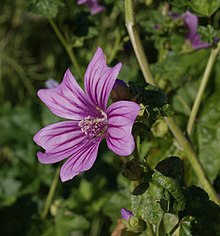Malva
| Malva | |
|---|---|
 |
|
| Malva sylvestris | |
| Scientific classification | |
| Kingdom: | Plantae |
| (unranked): | Angiosperms |
| (unranked): | Eudicots |
| (unranked): | Rosids |
| Order: | Malvales |
| Family: | Malvaceae |
| Subfamily: | Malvoideae |
| Tribe: | Malveae |
| Genus: |
Malva L. |
| Type species | |
|
M. sylvestris |
|
| Species | |
|
About 25–30; see text. |
|
| Synonyms | |
|
Axolopha (DC.) Alef. |
|
About 25–30; see text.
Axolopha (DC.) Alef.
Dinacrusa G.Krebs
Malva is a genus of about 25–30 species of herbaceous annual, biennial, and perennial plants in the family Malvaceae (of which it is the type genus), one of several closely related genera in the family to bear the common English name mallow. The genus is widespread throughout the temperate, subtropical and tropical regions of Africa, Asia and Europe. The word "mallow" is derived from Old English "malwe", which was imported from Latin "malva", cognate with Ancient Greek μαλάχη (malakhē) meaning "mallow", both perhaps reflecting a Mediterranean term. A number of species, previously considered to belong to Lavatera, have been moved to Malva.
The leaves are alternate, palmately lobed. The flowers are from 0.5–5 cm diameter, with five pink or white petals.
The colour mauve was in 1859 named after the French name for this plant.
Several species are widely grown as garden flowers, while some are invasive weeds, particularly in the Americas where they are not native.
Many species are edible as leaf vegetables and commonly foraged in the West. Known as ebegümeci in Turkish, it is used as vegetable in Turkey in various forms such as stuffing the leaves with bulgur or rice or using the boiled leaves as side dish. Malva verticillata (Chinese: 冬寒菜; pinyin: dōngháncài, Korean: 아욱 auk) is grown on a limited commercial scale in China; when made as a herbal infusion, it is used for its colon cleansing properties and as a weight loss supplement.
...
Wikipedia
